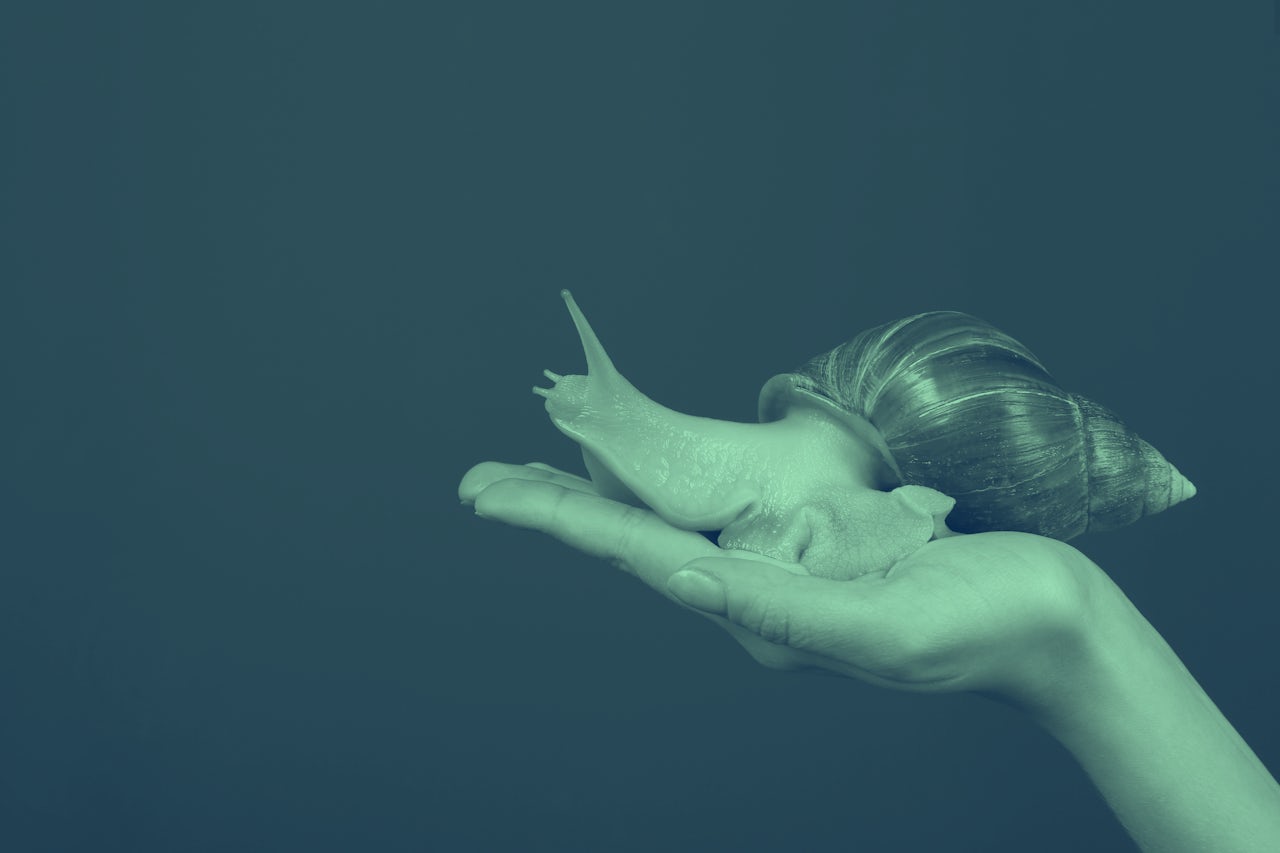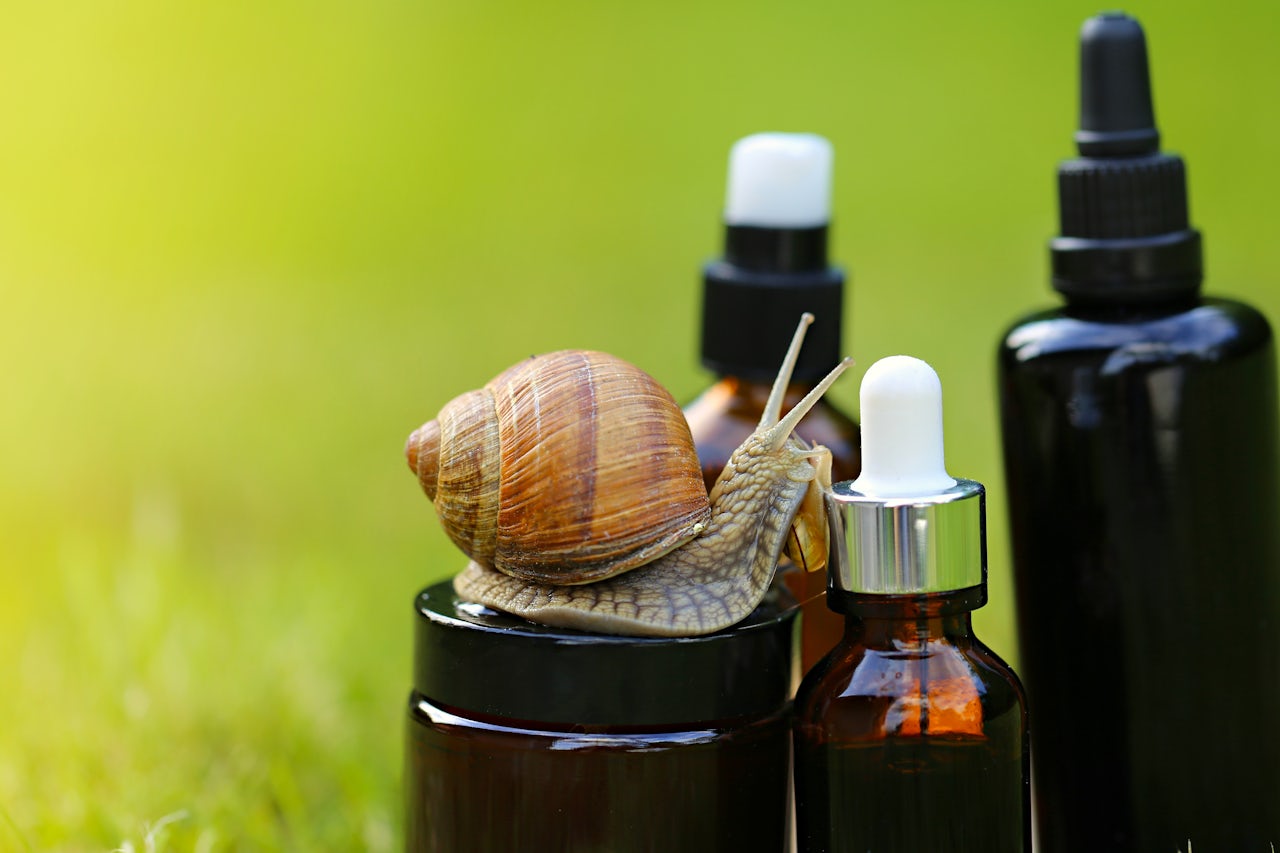Snails are having a moment, at least as far as skincare goes. In recent years, products infused with snail mucin, or slime, have been popping up in American drugstores and luxury beauty stores alike, with offerings ranging from affordable snail mucin face masks to a $300 “EscarGlow” facial. Though I haven’t yet reached “get snail mucin injected into my face” levels, I’m not above rubbing snail secretions on my skin if it means I’ll eventually have the glowing, blemish-free cheeks of a Renaissance-painting cherub. As I slather on gloopy slime three times a week, though, I try to avoid thinking about the snails that produced it. In my pursuit of great skin, am I inadvertently contributing to the torture and murder of innocent snails?
Though snail mucin has been the subject of various trend pieces in recent years, using these secretions for cosmetic purposes isn’t new. The Chilean skincare brand Elicina was among the first to use snail secretions in its products, claiming that it was inspired by local farmers whose hands became softer upon handling garden snails. South Korea, which a 2017 Deloitte report called a “global innovation leader in skincare,” latched on to the trend soon after. And since 2011, South Korean cosmetics brands that sell snail-related skincare products have been flooding the U.S. skincare market, according to the market research firm Euromonitor International. Which brings us to the little-known world of snail farming.
Snails have been part of the human diet for over 30,000 years; there is even archeological evidence that suggests that the ancient Romans considered escargot a delicacy and raised snails in pens near their homes. Today, the global market for edible snails is worth about $1.2 billion, according to a 2017 report by The Irish Times. (These edible species are also used in mucin-infused products; otherwise, other kinds of snails, and their secretions, may be toxic to humans.) Notably, snail-slime infused skincare products may be more popular in countries where snails are traditionally eaten, including parts of Europe and Asia. Janice Kang, senior director of marketing and new business development in the Americas and Europe for Korean beauty brand DKCOS, recently told Racked that since snails are already “a big part of the diet and drinking culture” in Korea, it was easy for local farmers to transition from the food industry to the cosmetics industry.
As snail mucin’s popularity has surged, farmers have increased their output to accommodate both the new skincare market and robust demand from the culinary industry. In Italy, where there are more than 4000 snail farms, the global snail slime craze has been a boon for the heliciculture industry. “In the last 10 months alone, we’ve seen a 46 percent increase in snail slime, due to demand from the cosmetics industry,” Simone Sampo, President of Italy’s National Heliciculture Association, told The Telegraph last year. Moroccan snail farmers also benefited: 85 percent of the 10 tons of snails raised there annually are exported to cosmetics companies, and the country’s farmers plan on increasing their output, the Morocco World News reported last year.
Still, divining how farmers extract the mucin can at times prove elusive. The Polish company Aspersa Snails International, which has a 1.5 hectare farm in the city of Grodziec and has been in business since 2011, works with an Italian lab to provide mucin to skincare companies. Bartłomiej Mielnik, whose family owns the farm, told The Outline that the company exports most of its snails to France, Italy, and Spain for culinary purposes, but also works with the aforementioned lab — which he declined to name — to extract mucin from their snails.
“They put the snails into a special machine and the snails produce the mucus,” he said. “Afterwards, we take them back to the farm. After processing, they should be on the farm for about two months so they can eat and be strong again.” Mielnik said that this process doesn’t harm the snails, but clarified that they need to be able to “regenerate” post-extraction so they can produce more slime.
Mielnik’s reticence regarding extraction methods points to a common theme in the snail skincare industry. Siam Snail, which reportedly uses a manual technique to induce snail slime, invited a Racked reporter on a press tour with the promise of getting an inside look at the mucin extraction process. Instead, she was taken on a tour of the farm and given some complimentary skin cream. Siam Snail’s board of directors, she was later told, had decided they wanted to keep the extraction process confidential. According to Racked, CosRX team manager Hye-Young Lee said the company wouldn’t allow any filming at its facilities due to concerns that “their refinement technique [could] be leaked.” (CosRX did not respond to The Outline’s request for comment.)
Heliciculturists and cosmetics labs may not reveal their mucin-extraction techniques in detail, but they tend to emphasize that these techniques don’t harm the snails. Older extraction methods involved dunking snails in pots of water mixed with salt or vinegar, but several companies say they’ve developed processes that don’t injure snails — presumably not only to assuage the fears of animal rights activists like PETA, who claim captive snails suffer from the effects of captivity and stress even when farms use these allegedly humane methods, but also to maximize profits. (If you have to kill a snail in order to extract its slime, you’re going to need a lot more snails than if you find a way to keep them alive.)
One Italian cosmetics lab, Donatella Veroni, has developed a machine called the OzoSnail, which the company says preserves “the total health of the mollusc,” especially when compared to “other extraction methods which use invasive and damaging techniques,” like sodium chloride, acetic acid, or ammonia. In 2013, a French farmer named Louis-Marie Guedon claimed he had developed a “secret technique” for producing 15 tons of snail mucin every year, Cosmetics Design Europe reported. The process involved using salt to extract the snail slime, but Guedon maintained that the animals weren’t harmed by the process.
Some mucin products use slime extracted from the Cornu aspersum species of snail, also known as the little gray snail or the garden snail. South Korean skincare company CosRX, however, uses mucin harvested from the Achatina fulica, or the giant African snail. A CosRX spokesperson told the K-beauty blog The Klog that its mucin is sourced from a company called CoSeedBoPharm Co. “The snails are placed over a mesh in a dark and quiet room,” a CosRX spokesperson told the website. “For about 30 minutes, the snails are left alone to freely roam the net, leaving mucin in their trails. Throughout the process, there is no external process applied to the snails or the mesh to force mucin production.”
Snail slime may have recently become a popular skincare product in the U.S., but the American heliciculture industry is relatively small. (One American snail farmer told The Outline he estimates there are two or three snail farms in the U.S., including his own.) “This country doesn’t have a tradition of eating snails,” said Ric Brewer, owner and head wrangler of Little Gray Farms, a snail farm in Quilcene, Washington that raises the the Cornu aspersum species for gastronomy, not cosmetics (“wrangler” means he handles the snails). “The snails that are typically not used for escargot are not native to this country, even though at least one [species] has been here for hundreds of years.” Because these creatures aren’t native to the U.S., he said, the USDA considers several snail types, including the little gray, an invasive species. On its website, the agency describes snails as “agricultural pests” with the potential to “cause considerable crop damage.”
Brewer said that currently, he has no plans to expand into the skincare game. “I’m working towards having [Little Gray Farms] be more sustainable in terms of what I can produce,” he said. “Skincare would take significantly more [snails]. Though from what I understand, with the new machines that have been developed in Italy, you don’t need to kill the snails in order to get slime from them.”
The Long Island-based farm Peconic Escargot, which was founded in 2015 and was the first snail farm to be USDA-certified in the country, also raises the Cornu aspersum for culinary markets. Taylor Knapp, the company’s founder and head snail wrangler, told The Outline that he looked into mucin production before determining it would be too costly. Cosmetics companies “can probably buy it cheaper from Europe than they’d be able to get it from us,” Knapp said. “To my knowledge, there’s definitely no one in the U.S. raising these things for cosmetic purposes right now.”
Despite snail mucin’s recent surge in popularity in the U.S., it’s still unclear whether these products actually have any long-term benefits. Snail slime acolytes claim that concentrated mucin has hydrating properties, can smooth out wrinkles and acne scars, and is capable of improving hyperpigmentation. Dermatologists and other experts, however, remain divided on the matter.
Some, like New York City plastic surgeon Dr. Matthew Schulman — the EscarGlow doctor — have hopped on to the snail slime train. At his Park Avenue office, Schulman injects patients’ faces with snail secretions through a process called microneedling. (The so-called “vampire facial” involves a similar technique, except with one’s own plasma instead of snail secretions.) “There is anecdotal evidence that proteins in snail slime have anti-aging benefits, and clinical trials have looked at that, as well as reversal of sun damage, and shown improvement,” Schulman told The Cut in 2015. Others are more skeptical. “From a marketing standpoint, the ingredients sound compelling,” plastic surgeon Joel Studin told The Cut. “However, there are no good studies to show it really works for anti-aging.”
Ric Brewer, the Washington snail farmer, said said he’s experienced the immediate benefits of snail mucin firsthand. “Snail slime contains glycoprotein, which is a protein that absorbs water. The cells of the protein fill with moisture, and that fills the cracks and wrinkles in skin, at least temporarily,” he said. “I usually wear food safety gloves [when handling snails], but the few times I have been harvesting, I will notice my hands are softer.”
Taylor Knapp, the Long Island farmer, says he has doubts about the efficacy of snail mucin. “We’ve got our hands on thousands of snails a week. My wife and I haven’t noticed softer hands, unfortunately,” he said. “So for now, it seems a bit gimmicky.”
Either way, I’ll probably keep rubbing snail serum on my face, but I’ll be thankful for the snails who helped me do it.
Correction: A previous version of this article incorrectly stated that Aspersa Snails International is located in Częstochowska. The farm is located in the Polish city of Grodziec.
Pocket Casts / Overcast / Stitcher / TuneIn / Alexa / Anchor / 60 dB / RadioPublic / RSS / “OK Google, play news from The Outline.”




